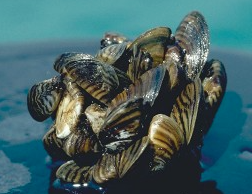TOPEKA, Kan. – The Kansas Department of Wildlife, Parks and Tourism (KDWPT) has confirmed the presence of invasive zebra mussels in Tuttle Creek Reservoir in Pottawatomie and Riley Counties. An alert fisherman found a rock with one adult zebra mussel attached and reported it to KDWPT staff in the Tuttle Creek State Park office. A subsequent search by KDWPT fisheries staff verified the presence of additional zebra mussels.
According to a media release, the 12,500 acre lake is located six miles north of Manhattan, KS on Hwy K-13. It is owned by the U.S. Army Corps of Engineers (USACE); KDWPT manages the fishery. The lake and surrounding areas are popular destinations for fishing, camping, swimming, hiking, and a variety of boating and other water-related activities.
While the zebra mussel population is currently small, there is no known method to completely rid a lake of this invasive species. The zebra mussels were likely introduced by “hitchhiking” with un-suspecting lake-goers. Adults are able to attach to boats or other equipment and the microscopic zebra mussels larvae (called veligers) may be present in any water originating from an infested lake or stream. Densities as high as 1,000 veligers per gallon have been recorded in KS waters. “Remembering to clean, drain, and dry boats and equipment before moving between waterbodies is the key to preventing the spread of zebra mussels and other aquatic nuisance species,” said Chris Steffen, aquatic nuisance species coordinator for KDWPT.
Tuttle Creek Reservoir, the connected downstream Tuttle Creek River Pond, and the Big Blue River downstream from the lake to the confluence with the Kansas River (including Rocky Ford) will be added to the list of ANS-designated waters in Kansas, and notices will be posted at various locations around the waterbodies. Live fish may not be transported from ANS-designated waters. The sharp-shelled zebra mussels attach to solid objects, so lake-goers should be careful when handling mussel-encrusted objects and when grabbing an underwater object when they can’t see what their hands may be grasping. Visitors should protect their feet when walking on underwater or shoreline rocks.
Zebra mussels are just one of the non-native aquatic species that threaten our waters and native wildlife. After using any body of water, people must remember to follow regulations and precautions that will prevent their spread:
- Clean, drain and dry boats and equipment between uses
- Use wild-caught bait only in the lake or pool where it was caught
- Do not move live fish from waters infested with zebra mussels or other aquatic nuisance species
- Drain livewells and bilges and remove drain plugs from all vessels prior to transport from any Kansas water on a public highway.
For more information about aquatic nuisance species in Kansas, report a possible ANS, or see a list of ANS-designated waters, visit ProtectKSWaters.org.
